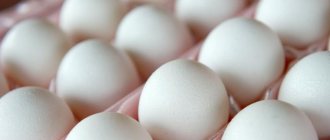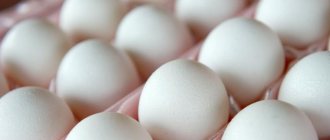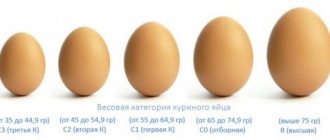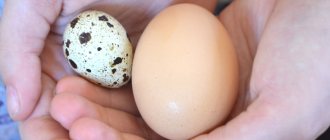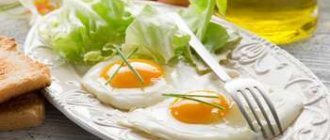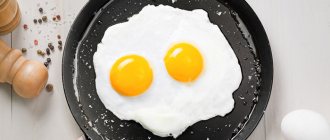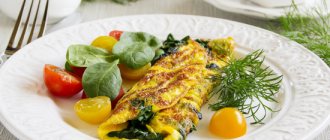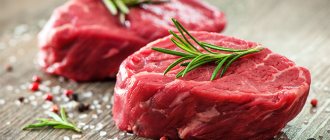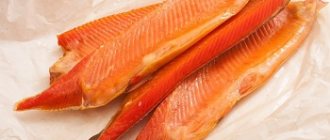Calorie content of fried eggs (1,2,3 pcs.)
100 grams of the product in its raw form contains 158 kcal. To grease a frying pan, you need at least 5 ml (teaspoon) of oil, which is 40 kcal.
Based on the specified parameters, it is easy to calculate the calorie content of the finished scrambled eggs:
| Chicken egg size | Raw (1 pc.) | Fried egg (calories 1 pc.) | Calorie content of scrambled eggs from 2 eggs | Calorie content of scrambled eggs from 3 eggs |
| Small (III category) | 75 | 105 | 190 | 265 |
| Secondary (I-II category) | 80-100 | 120-140 | 200-240 | 280-340 |
| Large (select and highest category) | 110 | 150 | 260 | 370 |
Properties
Let's forget for a second about the calorie content of a fried egg in oil and talk about how many eggs you can eat a day to maintain health, without harm. 1-2 pieces are enough!
We also recommend: Hazel and hazelnut: what is the difference
It is better to introduce the product into the diet in the morning or afternoon; in the evening you should avoid such dishes - they take a long time to digest and be absorbed by the body. However, it is permissible to consume it on an empty stomach after drinking half a glass of water or tea.
Benefit
What beneficial properties of eggs can we talk about? The list will be impressive:
- Gives a boost of vigor and energy;
- Improves the condition of hair and nails, increases skin elasticity;
- Normalizes blood sugar levels;
- Protects against anemia;
- Removes toxins and waste;
- Improves metabolism;
- Strengthens the immune system;
- Ensures normal functioning of the nervous system and brain function;
- Stimulates collagen production;
- Reduces calorie consumption and perfectly fills you up;
- Supports vision;
- Increases muscle tone.
Harm
The calorie content of 1 fried egg is low, which allows you to eat the product while on a diet. Everything is clear about the beneficial properties - what about possible harm?
This list is short - which is great. But there is something to talk about:
- Cholesterol. Yolks contain a lot of cholesterol, it is healthy and a person needs it in reasonable quantities. However, when frying, it burns, becomes harmful and negatively affects the figure and condition of blood vessels. There is nothing to worry about if you eat no more than 1-3 eggs;
- Salmonellosis. This is a bacterium that causes acute intestinal infection - you can avoid an unpleasant “meeting” if you subject the product to sufficient heat treatment. Therefore, it is not recommended to eat raw yolks;
- Digestive problems. If you add a lot of oil when frying, you may experience flatulence, heaviness, bloating and other unpleasant consequences. It is better to stop using it if you suffer from gastritis, ulcers, pancreatitis and other gastrointestinal diseases.
You can fix the problem in a simple way - use a small amount of olive oil or avoid it altogether. It is better to serve the dish with fresh vegetables and cheese.
We counted the calories in a fried egg, looked at the beneficial and harmful properties - it's time to discuss cooking methods!
We also recommend: Pistachios: calorie content
Calorie content depending on cooking method
Due to the evaporation of water during the frying process, the specific gravity of the product decreases, so the calorie content per 100 grams increases. In 100 grams of scrambled eggs, cooked without oil in a non-stick frying pan, there will be not 158 kcal, as in raw form, but already 170 kcal. That is, a serving of two fried eggs without fat will contain on average 250-260 kcal.
Frying with added fat will increase the nutritional value of each serving by the corresponding amount of kcal:
- butter – per 100 kcal (15 g);
- sunflower oil – 45 kcal (5 g);
- low-calorie margarine – 85 kcal (15 g);
- melted lard – 135 kcal (15 g).
Where is there more protein in chicken eggs or quail eggs?
Quail eggs have their advantages: they do not contain salmonellosis, they are less likely to cause allergies, and contain more macro and microelements. But if we talk about the concentration of proteins, quail contains 11.9%, according to this indicator they are slightly inferior to chicken, they also have fewer calories (158 kcal per 100 g).
BZHU, composition
A chicken egg, regardless of weight, consists of 73% water. Proteins account for 13% of the mass, fats make up 12%, the remaining 2% are carbohydrates and mineral salts. The yolk is the most nutritious part. It is where most of the vitamins (A, D, E, F, K, PP, group B), microelements (phosphorus, calcium, iron, magnesium, etc.), polyunsaturated and saturated fatty acids are concentrated.
The bulk of the fat is also included in the yolk, so its energy value is three times higher than that of the white.
Calorie content Chicken egg fried in sunflower oil. Chemical composition and nutritional value.
Nutritional value and chemical composition of “Chicken egg fried in sunflower oil.”
The table shows the nutritional content (calories, proteins, fats, carbohydrates, vitamins and minerals) per 100 grams of edible portion.
| Nutrient | Quantity | Norm** | % of the norm in 100 g | % of the norm in 100 kcal | 100% normal |
| Calorie content | 194 kcal | 1684 kcal | 11.5% | 5.9% | 868 g |
| Squirrels | 12.97 g | 76 g | 17.1% | 8.8% | 586 g |
| Fats | 16.57 g | 56 g | 29.6% | 15.3% | 338 g |
| Carbohydrates | 0.83 g | 219 g | 0.4% | 0.2% | 26386 g |
| Water | 69.84 g | 2273 g | 3.1% | 1.6% | 3255 g |
| Ash | 1.149 g | ~ | |||
| Vitamins | |||||
| Vitamin A, RE | 269 mcg | 900 mcg | 29.9% | 15.4% | 335 g |
| Retinol | 0.259 mg | ~ | |||
| beta carotene | 0.062 mg | 5 mg | 1.2% | 0.6% | 8065 g |
| Vitamin B1, thiamine | 0.08 mg | 1.5 mg | 5.3% | 2.7% | 1875 |
| Vitamin B2, riboflavin | 0.506 mg | 1.8 mg | 28.1% | 14.5% | 356 g |
| Vitamin B4, choline | 288.51 mg | 500 mg | 57.7% | 29.7% | 173 g |
| Vitamin B5, pantothenic | 1.494 mg | 5 mg | 29.9% | 15.4% | 335 g |
| Vitamin B6, pyridoxine | 0.161 mg | 2 mg | 8.1% | 4.2% | 1242 g |
| Vitamin B9, folates | 8.046 mcg | 400 mcg | 2% | 1% | 4971 g |
| Vitamin B12, cobalamin | 0.598 mcg | 3 mcg | 19.9% | 10.3% | 502 g |
| Vitamin D, calciferol | 2.529 mcg | 10 mcg | 25.3% | 13% | 395 g |
| Vitamin E, alpha tocopherol, TE | 0.69 mg | 15 mg | 4.6% | 2.4% | 2174 g |
| Vitamin H, biotin | 23.218 mcg | 50 mcg | 46.4% | 23.9% | 215 g |
| Vitamin K, phylloquinone | 0.3 mcg | 120 mcg | 0.3% | 0.2% | 40000 g |
| Vitamin RR, NE | 2.6416 mg | 20 mg | 13.2% | 6.8% | 757 g |
| Niacin | 0.218 mg | ~ | |||
| Macronutrients | |||||
| Potassium, K | 160.92 mg | 2500 mg | 6.4% | 3.3% | 1554 g |
| Calcium, Ca | 63.22 mg | 1000 mg | 6.3% | 3.2% | 1582 g |
| Magnesium, Mg | 13.79 mg | 400 mg | 3.4% | 1.8% | 2901 g |
| Sodium, Na | 154.02 mg | 1300 mg | 11.8% | 6.1% | 844 g |
| Sera, S | 202.3 mg | 1000 mg | 20.2% | 10.4% | 494 g |
| Phosphorus, P | 220.7 mg | 800 mg | 27.6% | 14.2% | 362 g |
| Chlorine, Cl | 179.31 mg | 2300 mg | 7.8% | 4% | 1283 g |
| Microelements | |||||
| Iron, Fe | 2.874 mg | 18 mg | 16% | 8.2% | 626 g |
| Yod, I | 22.99 mcg | 150 mcg | 15.3% | 7.9% | 652 g |
| Cobalt, Co | 11.494 mcg | 10 mcg | 114.9% | 59.2% | 87 g |
| Manganese, Mn | 0.0333 mg | 2 mg | 1.7% | 0.9% | 6006 g |
| Copper, Cu | 95.4 mcg | 1000 mcg | 9.5% | 4.9% | 1048 g |
| Molybdenum, Mo | 6.897 mcg | 70 mcg | 9.9% | 5.1% | 1015 g |
| Selenium, Se | 36.437 mcg | 55 mcg | 66.2% | 34.1% | 151 g |
| Fluorine, F | 63.22 mcg | 4000 mcg | 1.6% | 0.8% | 6327 g |
| Chromium, Cr | 4.6 mcg | 50 mcg | 9.2% | 4.7% | 1087 g |
| Zinc, Zn | 1.2759 mg | 12 mg | 10.6% | 5.5% | 941 g |
| Digestible carbohydrates | |||||
| Mono- and disaccharides (sugars) | 0.805 g | max 100 g | |||
| Sterols (sterols) | |||||
| Cholesterol | 655.17 mg | max 300 mg | |||
| Saturated fatty acids | |||||
| Saturated fatty acids | 3.4 g | max 18.7 g | |||
| Monounsaturated fatty acids | 6.182 g | min 16.8 g | 36.8% | 19% | |
| Polyunsaturated fatty acids | 3.251 g | from 11.2 to 20.6 g | 29% | 14.9% | |
| Omega-3 fatty acids | 0.207 g | from 0.9 to 3.7 g | 23% | 11.9% | |
| Omega-6 fatty acids | 3.042 g | from 4.7 to 16.8 g | 64.7% | 33.4% |
The energy value of a chicken egg fried in sunflower oil is 194 kcal.
Primary Source: Created in the application by the user. Read more.
** This table shows the average levels of vitamins and minerals for an adult. If you want to know the norms taking into account your gender, age and other factors, then use the “My Healthy Diet” application.
Calorie content per serving according to different recipes
When adding any components to scrambled eggs, you should remember that the energy value of the finished dish will directly depend on this. Some products can almost double this figure.
Popular recipes:
| Additional Ingredients | Amount per serving of two eggs, g | Cooking method | Kcal in finished portion |
| Bacon | 100 | Cut the bacon into thin strips, fry on both sides without oil; break the eggs, add salt to taste | 440 |
| Milk sausages (2 pcs.) | 110 | Cut the sausages into slices, fry in vegetable oil; pour in eggs, fry for 3-4 minutes | 510 |
| Tomatoes and onions | Tomatoes-95; onion - 50 | Fry the onion with sunflower oil until golden brown; add the tomatoes cut into pieces, simmer for 2-3 minutes, pour in the eggs (stir if desired) | 340 |
| Champignon mushrooms) | 75 | Cut the champignons, fry with vegetable oil for 3-5 minutes; pour in the beaten egg mixture, fry covered until done | 240 |
| Croutons (wheat bread) | 100 | Cut the bread into small cubes, fry for 1-2 minutes in sunflower oil; pour in the eggs, fry covered over low heat for 3-4 minutes | 575 |
| Cheese and greens | Russian cheese - 50; dill - 10 | Pour the beaten egg mixture into a heated frying pan; after 2 minutes add chopped dill and grated cheese | 420 |
Categories of chicken eggs
There are dietary ones, which can be stored for no longer than 7 days (marked with the letter D) and table ones (C) with a more impressive shelf life. Depending on the size, according to GOST R 55502-2013, products are divided into categories:
| Category | Letter designation | Weight 1 piece, g |
| Higher | XL | 75 g or more |
| Selective | L | 65-74,9 |
| First | M | 55 to 64.9 |
| Second | S | 45-54,9 |
| Third | no designation | 35-44,9 |
The price depends greatly on the category: the larger the product, the more expensive it is. But this has little effect on the nutritional value (the ratio of BJU and calorie content): 1 large or 2 small pieces provide the same benefits to the body.
How much does the protein weigh in other types of eggs?
In stores, in addition to chicken eggs, you can find quail, duck and even sometimes ostrich eggs, but how much protein is in 1 piece? Small quail eggs contain slightly more protein than chicken eggs per 100 g. On average, each such egg weighs no more than 10-12 g, so 1 raw or boiled quail egg contains 1.3-1.5 g of protein.
The largest eggs are ostrich eggs. Their weight reaches 750-780 grams, so one such egg contains up to 80-100 g of protein (raw, boiled or fried, almost the same). One raw ostrich egg white weighs about 450-470 g, but protein is also contained in the yolk.
As for the eggs of waterfowl (ducks and geese), they are rarely eaten due to a possible source of infection, which is not always killed during heat treatment. One duck egg contains up to 10-12 g of protein, and it is approximately twice the size of a chicken egg.
Goose eggs are four times the size of chicken eggs, and each egg contains 22-25 g of protein. Rarely found turkey eggs also exist. Weight 1 pc. is about 80 g, and the protein in it is about 8-11 g.
How long can egg whites be stored in the refrigerator?
The shell is a reliable barrier; it protects the contents from spoilage for 20 days without refrigeration. If the product is kept at a temperature of 0 to 5 degrees, then it can be consumed for 60 days. Separated egg whites are a different matter entirely. They can be stored in the refrigerator for no longer than 5 days in a closed jar. For longer storage, it is better to freeze them. True, in this case they partially lose their ability to whip into a fluffy foam.
The amount of protein in one egg is not the highest when compared to other animal products. But it is the most complete, including absolutely all essential amino acids. Because of this, steamed omelettes are allowed on all diets.
Amount of protein in one egg
No reference book contains exact information on how many grams of protein are in one egg, since they differ in origin, size and methods of preparation. If you are not interested in scientific accuracy and you are not going to weigh every chicken egg you take from the refrigerator, remember the following values:
- 1 small egg (they weigh up to 40 g, where the protein weight is 23-28 g) contains approximately 5 g of protein;
- in a medium-sized egg (about 45 g) – 5.7-6 g of protein;
- in large (about 50 g) – 6.5 g of protein;
- in very large (up to 55 g total weight and approximately 35-40 protein) – 7.3 g of protein;
- 1 huge chicken egg contains up to 8 g of protein or more, and the weight of such an egg is 63-65 g.
It turns out that you can determine how much protein is in one chicken egg using the simplest formula: the amount of protein is approximately 1/8 of the total mass. This is not the most accurate calculation, but many athletes use it because it is important for them to consume enough protein.
And one more interesting fact about chicken eggs. If you don’t know exactly how much protein is in one boiled or fried egg, you might think that it is predominantly contained in the protein. It is also present in the yolk, and in considerable quantities!
